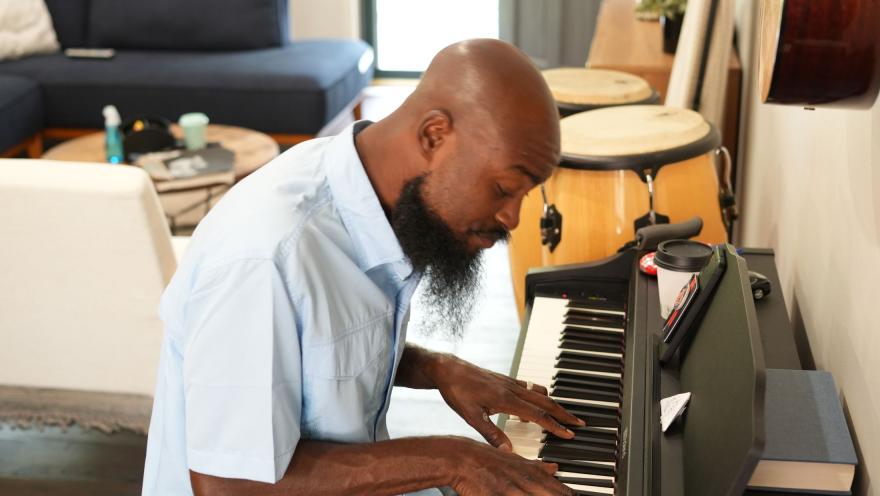In recognition of National Wellness Month, we are exploring the many facets of wellness and the ALS community, shining a spotlight on the act of practicing healthy habits to attain better physical and mental health outcomes.
There are certain pieces of music that can instantly take our minds to a certain time or place, bringing back memories and emotions with the sound of just a few notes. But the benefits of music are not merely emotional. Research has shown that it can help reduce anxiety, blood pressure, and pain as well as improve sleep quality, mood, mental alertness, and memory.
For people living with ALS, both listening to and playing music can be beneficial to mental health and wellness and can provide an important connection to family, friends and community. Whether through informal gatherings with a favorite instrument, participating in a music therapy program, or just listening to a familiar Spotify playlist, music can help improve quality of life for people with ALS and their families.
But while the benefits of listening to music are available at all stages of the disease, as ALS progresses, the ability to participate by playing and creating music can become more challenging with the loss of motor function. But that doesn’t mean the ability to create music, and the ability to collaborate with others around music is entirely gone. Enter DuoRhythmo.
Created by a group of six MSc Medialogy students affiliated with the Multisensory Experience Lab at Aalborg University in Copenhagen, Denmark, in collaboration with Enable Group from Microsoft Research and the International Alliance of ALS/MND Associations, DuoRhythmo is a Windows app that enables anyone to create music collaboratively and remotely in real-time using an eye gaze device.
Two members of the development team, Ivanyl Balazs and Truls Tjemsland, presented on how the app came about, what it can do right now, and their plans for the future at the International Alliance of ALS/MND Association meeting in late 2022.
DuoRhythmo allows a user to create music on their own, but the “duo” aspect of the tool—allowing users to collaborate—was important from the beginning of development. “We felt that this is such a significant and pivotal part to playing music, to actually interact with each other,” Balazs said. “To actually jam together to have that connection through music.”

While there were the expected technological challenges in developing the app, the team also had to do a good amount of learning about ALS and what was important to the end users. For instance, they learned people using eye trackers need a resting space on the screen where they aren’t interacting with anything. They also found ways to ensure it was enjoyable for people of all levels of musical aptitude.
“We learned that a lot of people don't really feel empowered by playing music and creating rhythm and patterns. So we realized that to cater for the novice users, we also wanted to include some very easy steps to make a fundamental beat,” Tjemsland said. “So it's very easy—by a click of a button (users) can create a nice and enjoyable soundscape.”
There are currently five different musical “rooms” with different beat and styles for participants to build their sounds off of, with plans for more in the future, and eventually the ability to create their own sounds for others to use as well. “We also have a friend system so you can add friends together and you can play together and invite each other to play,” Tjemsland said. “And lastly, we added this fun (feature) of sending quick reactions where you can sort of acknowledge the other person on the other side if you think the beat is especially good.”
Regardless of where you live or what language you speak, it’s safe to say we all share the love of a universal language: music. And enabling everyone, everywhere, to maintain a connection with the music they enjoy is truly a part of helping to maintain overall wellness, no matter the challenges.
DuoRhythmo is available as a free download from the Microsoft App store.
To continue to follow stories about people living with ALS in the community and learn more about the disease, subscribe to receive our weekly blogs in your inbox HERE or follow us at als.org/blog.


Join the conversation. Please comment below.